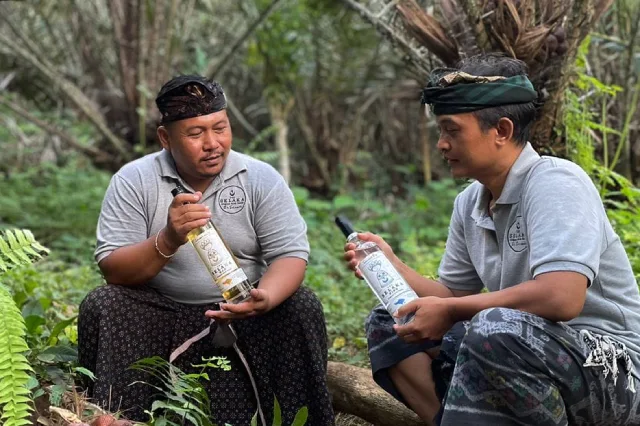Things to Do in Bali
Banded Sea Krait in Bali
The Banded Sea Krait, scientifically known as Laticauda colubrina and locally as Ular Laut Belang, is a fascinating and highly venomous sea snake found in the coastal waters around Bali. This snake is easily identified by its striking black and white bands that run the length of its body. The Banded Sea Krait is a proficient swimmer, aided by its flattened, paddle-like tail, and spends much of its life in the water. However, it must come to land to lay its eggs, making isolated coastal areas a common nesting site.
Despite their potent neurotoxic venom, which can cause paralysis and respiratory failure, Banded Sea Kraits are generally non-aggressive and rarely pose a threat to humans. They are more likely to be encountered by divers and snorkelers exploring coral reefs and rocky shores, where these snakes hunt for small fish and eels. On land, their poor vision makes them more vulnerable and defensive, but bites are still extremely rare and usually occur only if the snake feels threatened.
The Banded Sea Krait plays a crucial role in the marine ecosystem by controlling fish populations. Their unique life cycle, which includes both terrestrial and marine environments, underscores their adaptability and the importance of preserving their habitats. Understanding their behavior and habitat can enhance safe interactions while appreciating these remarkable creatures.
Banded Sea Krait
- Latin Name: Laticauda colubrina
- Bahasa Name: Ular Laut Belang
- Length: Up to 1.5 meters
- Danger Level: Highly venomous with neurotoxic venom, capable of causing paralysis and potentially death.
- Venom: Highly neurotoxic, causing paralysis and respiratory failure.
- Color: Black and white bands
- Specific Markers: Flattened tail for swimming. **Eye Shape:** Round pupils. **Head Shape:** Small, slightly distinct from the neck. **Eye Color:** Dark.
- Habitat: Coastal waters, often near coral reefs and rocky shores
- Activity: Diurnal and nocturnal
- Prevalence: Often found
- Region: Coastal waters around Bali
- Behavior: Generally non-aggressive. Bites are extremely rare and typically occur only when the snake feels threatened, especially when they are on land with poor vision. Underwater, they are docile and often seen foraging for small fish and other prey.
- Encounter Risk: Low. They are common around coral reefs and rocky shores but will usually avoid humans. Divers and snorkelers might see them, but the snakes are unlikely to bite unless provoked. The banded sea krait lays its eggs on land, so care should be taken in isolated coastal areas.

Source: Wikimedia Common
Conservation Status of the Banded Sea Krait (Laticauda colubrina)
Least Concern (LC) globally. It is locally common in coastal waters around Bali.
What Travelers want to know about Snakes in Bali
Yes, Bali is home to several dangerous snakes, including the King Cobra, Blue Krait, and Malayan Pit Viper. While these snakes are venomous, they are generally shy and avoid human contact, encounters with tourists are very very rare.
The Pythons can also be dangerous, depending ion their size and whether they feel threatened. It's important to be cautious, especially in rural and forested areas.
It is uncommon, but not impossible, to find snakes in Bali villas. Most villas are well-maintained and have measures in place to prevent wildlife from entering and gardeners keep the gardens free of potential habitats as much as possible. However, occasional sightings of non-venomous snakes like the Common Wolf Snake may occur, particularly in areas close to nature.
Snakes can be found in Ubud due to its lush, natural environment, but they are not commonly encountered by visitors. The area’s forests and rice fields provide habitats for various snake species.</p]
The most common snakes in Bali include the Common Wolf Snake and the Oriental Rat Snake. These non-venomous snakes are frequently found in gardens, forests, and near human settlements.
Bali hosts several venomous snakes, including the King Cobra, Blue Krait, Malayan Pit Viper, Javan Spitting Cobra, Green Tree Pit Viper, Island Pit Viper, Asian Coral Snake, Red-Necked Keelback Snake, Yellow-Bellied Sea Snake, and the Banded Sea Krait. These snakes possess potent venom but are typically shy and avoid human contact.
Yes, there are. Venomous sea snakes in Bali include the Yellow-bellied Sea Snake and the Banded Sea Krait. These snakes are usually found in coastal waters and are generally not aggressive towards humans.
Yes, there are non-venomous snakes in Bali. Non-venomous snakes include the Burmese Python, Reticulated Python, Common Wolf Snake, Oriental Rat Snake, Brahminy Blind Snake, Green Cat Snake, Red-tailed Pipe Snake, and the Chinese Rat Snake. These snakes are harmless to humans and play a vital role in controlling pest populations.
Identifying snakes in Bali can be challenging due to the variety of species. Yes, identifying snakes in Bali involves looking at key markers such as color patterns, head shape, and habitat. For detailed information, refer to our specific snake pages guides available on our website.
Yes. The King Cobra in Bali is known for its impressive size and potent venom. It is typically found in forests and rural areas. Despite its fearsome reputation, it tends to avoid human contact.
The Banded Krait is a venomous snake found in Bali, recognized by its distinctive black and yellow bands. It is generally nocturnal and prefers wetland habitats.</p]
The thin green snake in Bali is likely the (mostly) harmless Vine Snake or the Green Tree Pit Viper or the Island Pit Viper,, which is the snake that causes the most bites in Bali and is specifically found in the Lesser Sunda Islands of Indonesia, including Bali, Lombok, Sumbawa, and Komodo.
The striped snake in Bali could be the Blue Krait or the Banded Krait, both of which have distinct banding patterns and are venomous. These snakes are nocturnal and typically found in rural areas.
The likelihood of seeing a snake in Bali depends on your location and activities. While urban and tourist areas have fewer sightings, rural and forested areas have higher chances of encounters. However, snakes generally avoid human contact.
Besides snakes, other dangerous animals in Bali include certain species of spiders and scorpions. However, encounters with these creatures are rare, and they generally avoid human contact, and are not very venomous. It's more dangerous playing with a monkey in the Monkey Forest.
A key difference is how the toxins enter the body: venomous animals, like most snakes, inject toxins through a bite or sting, while poisonous animals release toxins when touched or ingested. The terms are often confused, and many people incorrectly call most snakes "poisonous" when they are actually "venomous".
List of Snakes in Bali
10 most common venomous Snakes in Bali
- King Cobra (Ophiophagus hannah)
- Blue Krait / Malayan Krait (Bungarus caeruleus)
- Banded Krait (Bungarus fasciatus)
- Malayan Pit Viper (Calloselasma rhodostoma)
- Javan Spitting Cobra (Naja sputatrix)
- Green Tree Pit Viper (Trimeresurus albolabris)
- Island Pit Viper (Trimeresurus insularis)
- Asian Coral Snake (Calliophis intestinalis)
- Red-Necked Keelback Snake (Rhabdophis subminiatus)
- Vine Snake (Ahaetulla prasina)
Venomous Sea Snakes around Bali
Common Non-Venomous Snakes in Bali
- Oriental Rat Snake (Ptyas mucosa)
- Common Wolf Snake (Lycodon capucinus)
- Brahminy Blind Snake (Indotyphlops braminus)
- Green Cat Snake (Boiga cyanea)
- Red-tailed Pipe Snake (Cylindrophis ruffus)
- Chinese Rat Snake (Ptyas korros)
- Bronzeback Snake (Dendrelaphis pictus)
- Sunbeam Snake (Xenopeltis unicolor)






















